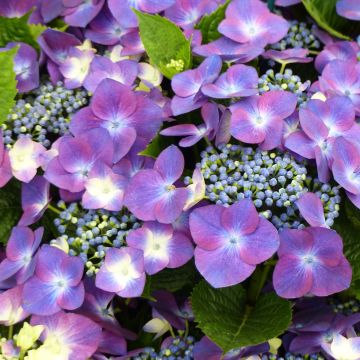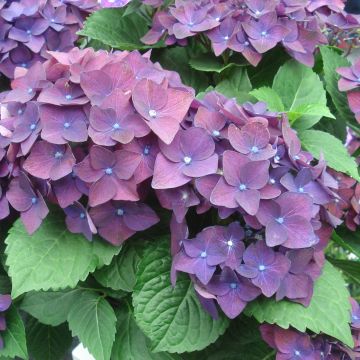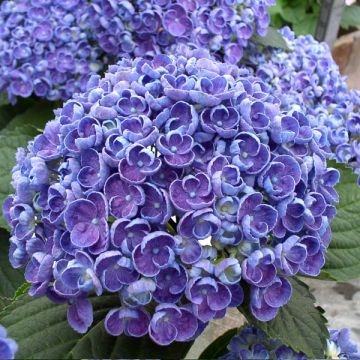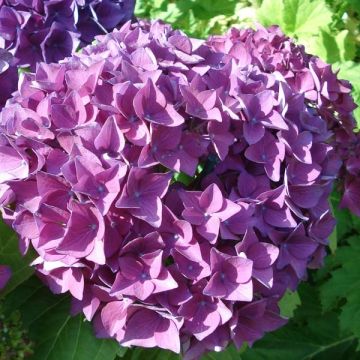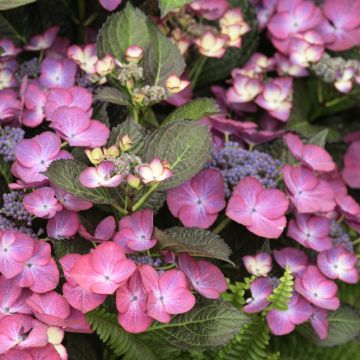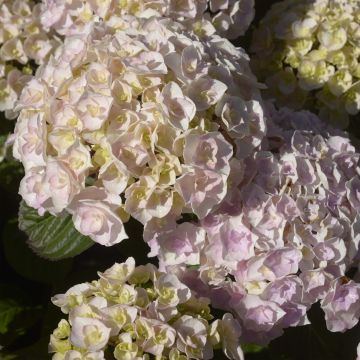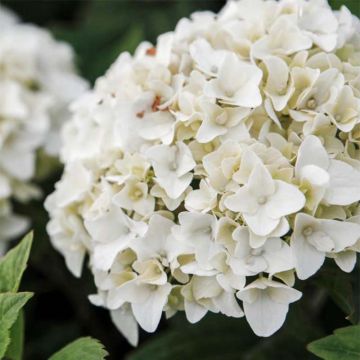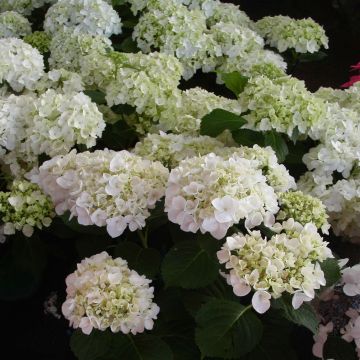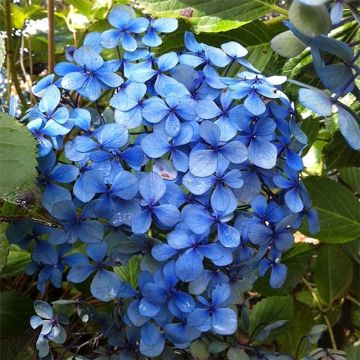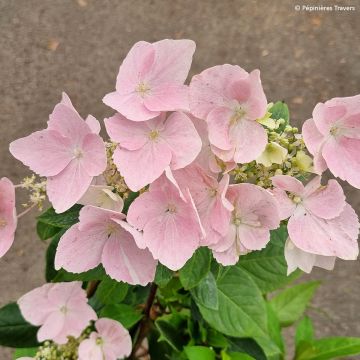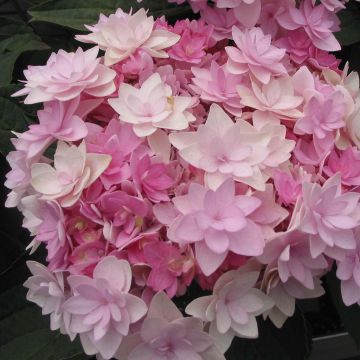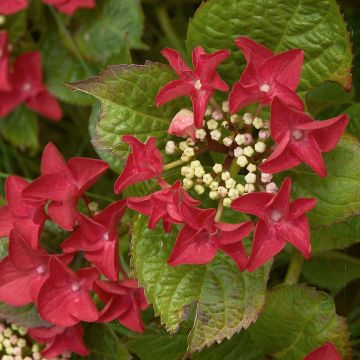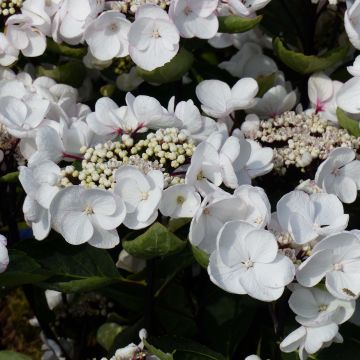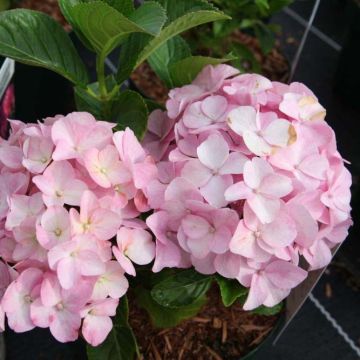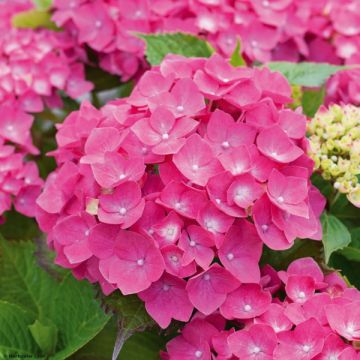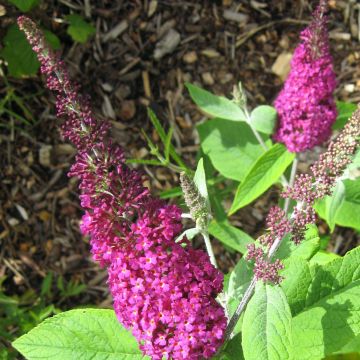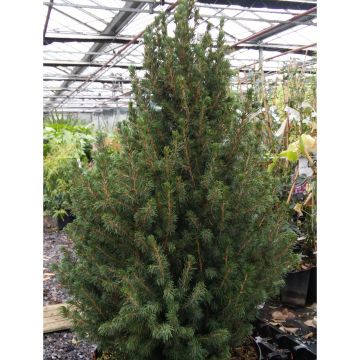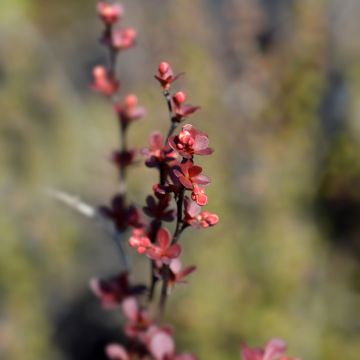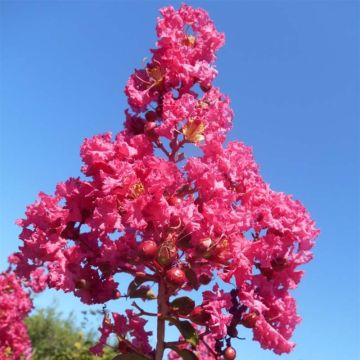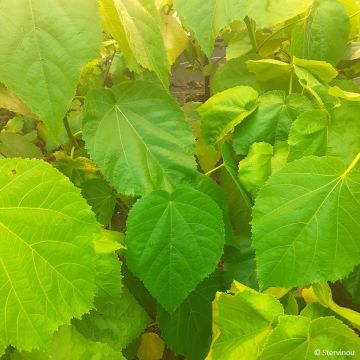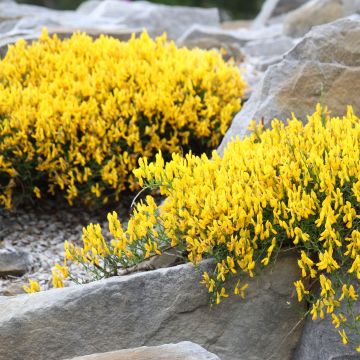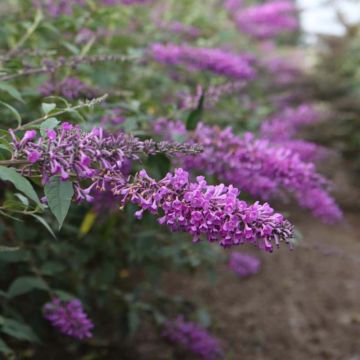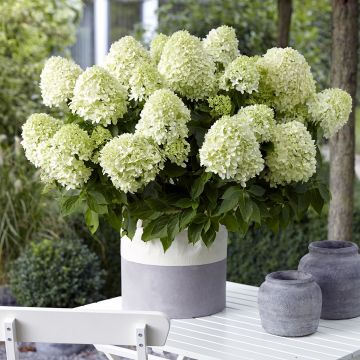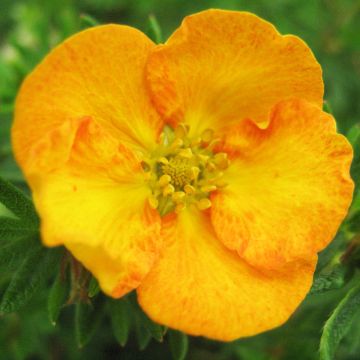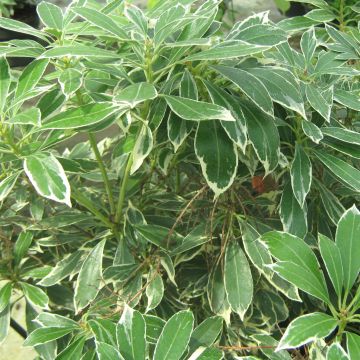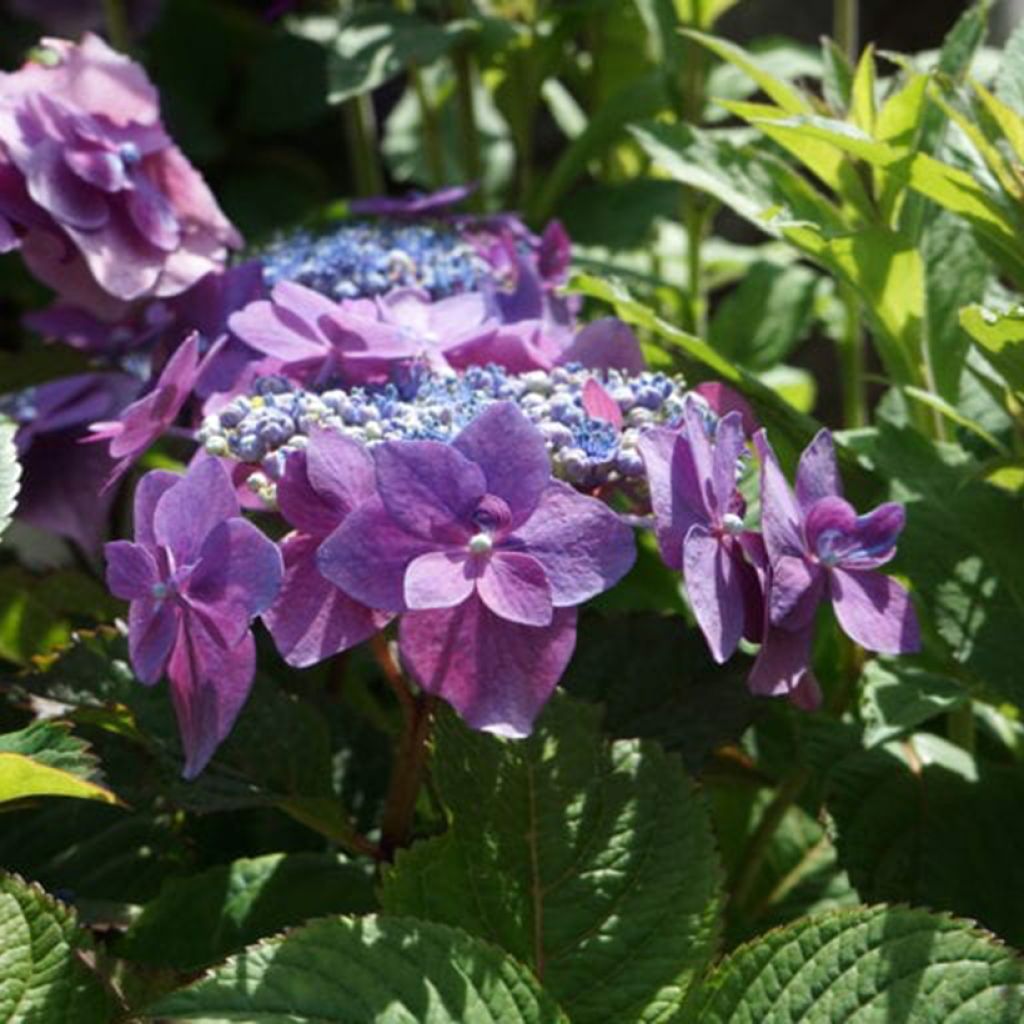

Hydrangea macrophylla x serrata Flair & Flavours Blackberry Pie
Hydrangea macrophylla x serrata Flair & Flavours Blackberry Pie
Hydrangea macrophylla x serrata Flair & Flavours® Blackberry Pie
Mountain Hydrangea, Lacecap Hydrangea, Bigleaf Hydrangea.
Why not try an alternative variety in stock?
View all →This plant carries a 24 months recovery warranty
More information
We guarantee the quality of our plants for a full growing cycle, and will replace at our expense any plant that fails to recover under normal climatic and planting conditions.
From €5.90 for pickup delivery and €6.90 for home delivery
Express home delivery from €8.90.
Does this plant fit my garden?
Set up your Plantfit profile →
Description
The Hydrangea macrophylla Flair & Flavours 'Blackberry Pie' is a lacecap Hydrangea with both sterile and fertile florets, whose colour varies depending on the acidity of the soil. In acidic soil, the colour of the sterile florets is blue-violet, while in less acidic soil, it is red-pink. The fertile florets in the centre are pale yellow buds tinted with light blue or light pink. The foliage is dark green with a touch of purple. This hardy variety forms a compact bush and should be placed in a partially shaded spot with non-calcareous soil. It is easy to grow, requiring only annual pruning in spring and regular watering in summer to keep the soil moist.
The Hydrangea macrophylla is a deciduous bush native to Japan, where its beauty has been appreciated for centuries and mentioned in poems dating back to the 8th century! In a country that values plants highly, festivals are even dedicated to this bush. It is found in the wild on the island of Honshu (home to the capital Tokyo) and was introduced to Europe around 1789. This bush is also highly appreciated in Europe by professionals, including nurserymen who specialise in its production and breeders who have selected dozens of cultivars, as well as by amateurs.
This Flair & Flavours Blackberry Pie Hydrangea is a compact variety, reaching about 1m in all directions. It forms a beautiful, well-structured tuft with healthy, fairly dark green foliage with serrated edges. Its inflorescences appear in July and last until September or October. The flat heads are made up of both sterile and fertile florets, whose colour varies depending on the acidity of the soil. If the soil is acidic and contains enough Aluminium ions (Al3+), the inflorescences will take on a blue to violet hue. In neutral or slightly alkaline soil, they will be pink-red. In both cases, it can be said that this beautiful bush exudes a charm full of romance. In autumn, its foliage usually takes on beautiful colours, adding to its ornamental interest.
As a small bush, this Hydrangea, like all H. macrophylla, is not strictly an ericaceous soil plant, but it prefers neutral to acidic soil. It will thrive in a partially shaded to shaded position in hot climates, as well as regular watering in summer, as it does not tolerate drought (both in the soil and in the air), which can cause its leaves to wilt. In less sunny climates, it can be planted in an open space. Care consists of annual pruning in spring, before the new leaves emerge. This bush with its long summer flowering period is highly hardy (-20°C or more, although severe frost can damage the tips of the branches, they will easily regenerate after pruning in spring). Easy to grow, it can live for a very long time.
The 'Blackberry Pie' Hydrangea is an excellent variety for container gardening, on a balcony or a terrace sheltered from the afternoon sun. A thick terracotta pot would be suitable, and if using a plastic container, preferably choose a "double skin" one, with two walls separated by an air gap, creating an insulating layer that prevents the potting soil from overheating and the roots from getting too hot in summer, and also provides some protection against frost in winter. Use a potting mix for ericaceous plants, adding a bit of compost. Water regularly during hot periods. When planted in the garden, place it in a slightly shaded border, on the edge of trees, alongside plants with similar needs. To extend the flowering season, consider Witch Hazels for late winter, Chinese Azaleas and Deciduous Magnolias for spring, and Camellia sasanqua for autumn.
Report an error about the product description
Plant habit
Flowering
Foliage
Botanical data
Hydrangea
macrophylla x serrata
Flair & Flavours® Blackberry Pie
Hydrangeaeceae
Mountain Hydrangea, Lacecap Hydrangea, Bigleaf Hydrangea.
Hydrangea macrophylla 'Mak2' Blackberry Pie ( FLAIR & FLAVOURS series )
Cultivar or hybrid
Other Hydrangea Macrophylla
Planting and care
Plant the hydrangea macrophylla Flair & Flavours Blackberry Pie in spring or early autumn, preferably in a slightly shaded location, for example against an east-facing wall or even north-facing. In very cold regions, it may be prudent to protect the stump with a thick mulch. Keep it sheltered from cold and drying winds. It does not necessarily require ericaceous soil, but appreciates a deep, moist but well-drained, and fairly fertile soil. In poor soil, enrich with a good base fertiliser before planting, and mix the existing soil with a substrate containing compost...
If the soil is dry at the base of the wall, plant the root ball at least 30-40 cm away from the base of the wall, and incorporate plenty of well-rotted compost to better retain moisture in the soil. After planting, be mindful of slugs, as they are quite fond of young leaves. Very hardy, it can be planted in cold regions without fear. Water regularly during hot periods to prevent the foliage from wilting during dry spells.
This variety of Hydrangea is also particularly suitable for growing in pots or decorative containers due to its relatively compact size. In this case, make sure to choose a potting mix for ericaceous plants and water regularly to keep the substrate moist. In case of a cold winter, shelter the pot at the corner of a wall, or even in a garage in the event of severe frost, as potted plants expose the roots more to freezing temperatures.
Planting period
Intended location
Care
This item has not been reviewed yet - be the first to leave a review about it.
Shrubs for pots
Haven't found what you were looking for?
Hardiness is the lowest winter temperature a plant can endure without suffering serious damage or even dying. However, hardiness is affected by location (a sheltered area, such as a patio), protection (winter cover) and soil type (hardiness is improved by well-drained soil).

Photo Sharing Terms & Conditions
In order to encourage gardeners to interact and share their experiences, Promesse de fleurs offers various media enabling content to be uploaded onto its Site - in particular via the ‘Photo sharing’ module.
The User agrees to refrain from:
- Posting any content that is illegal, prejudicial, insulting, racist, inciteful to hatred, revisionist, contrary to public decency, that infringes on privacy or on the privacy rights of third parties, in particular the publicity rights of persons and goods, intellectual property rights, or the right to privacy.
- Submitting content on behalf of a third party;
- Impersonate the identity of a third party and/or publish any personal information about a third party;
In general, the User undertakes to refrain from any unethical behaviour.
All Content (in particular text, comments, files, images, photos, videos, creative works, etc.), which may be subject to property or intellectual property rights, image or other private rights, shall remain the property of the User, subject to the limited rights granted by the terms of the licence granted by Promesse de fleurs as stated below. Users are at liberty to publish or not to publish such Content on the Site, notably via the ‘Photo Sharing’ facility, and accept that this Content shall be made public and freely accessible, notably on the Internet.
Users further acknowledge, undertake to have ,and guarantee that they hold all necessary rights and permissions to publish such material on the Site, in particular with regard to the legislation in force pertaining to any privacy, property, intellectual property, image, or contractual rights, or rights of any other nature. By publishing such Content on the Site, Users acknowledge accepting full liability as publishers of the Content within the meaning of the law, and grant Promesse de fleurs, free of charge, an inclusive, worldwide licence for the said Content for the entire duration of its publication, including all reproduction, representation, up/downloading, displaying, performing, transmission, and storage rights.
Users also grant permission for their name to be linked to the Content and accept that this link may not always be made available.
By engaging in posting material, Users consent to their Content becoming automatically accessible on the Internet, in particular on other sites and/or blogs and/or web pages of the Promesse de fleurs site, including in particular social pages and the Promesse de fleurs catalogue.
Users may secure the removal of entrusted content free of charge by issuing a simple request via our contact form.
The flowering period indicated on our website applies to countries and regions located in USDA zone 8 (France, the United Kingdom, Ireland, the Netherlands, etc.)
It will vary according to where you live:
- In zones 9 to 10 (Italy, Spain, Greece, etc.), flowering will occur about 2 to 4 weeks earlier.
- In zones 6 to 7 (Germany, Poland, Slovenia, and lower mountainous regions), flowering will be delayed by 2 to 3 weeks.
- In zone 5 (Central Europe, Scandinavia), blooming will be delayed by 3 to 5 weeks.
In temperate climates, pruning of spring-flowering shrubs (forsythia, spireas, etc.) should be done just after flowering.
Pruning of summer-flowering shrubs (Indian Lilac, Perovskia, etc.) can be done in winter or spring.
In cold regions as well as with frost-sensitive plants, avoid pruning too early when severe frosts may still occur.
The planting period indicated on our website applies to countries and regions located in USDA zone 8 (France, United Kingdom, Ireland, Netherlands).
It will vary according to where you live:
- In Mediterranean zones (Marseille, Madrid, Milan, etc.), autumn and winter are the best planting periods.
- In continental zones (Strasbourg, Munich, Vienna, etc.), delay planting by 2 to 3 weeks in spring and bring it forward by 2 to 4 weeks in autumn.
- In mountainous regions (the Alps, Pyrenees, Carpathians, etc.), it is best to plant in late spring (May-June) or late summer (August-September).
The harvesting period indicated on our website applies to countries and regions in USDA zone 8 (France, England, Ireland, the Netherlands).
In colder areas (Scandinavia, Poland, Austria...) fruit and vegetable harvests are likely to be delayed by 3-4 weeks.
In warmer areas (Italy, Spain, Greece, etc.), harvesting will probably take place earlier, depending on weather conditions.
The sowing periods indicated on our website apply to countries and regions within USDA Zone 8 (France, UK, Ireland, Netherlands).
In colder areas (Scandinavia, Poland, Austria...), delay any outdoor sowing by 3-4 weeks, or sow under glass.
In warmer climes (Italy, Spain, Greece, etc.), bring outdoor sowing forward by a few weeks.

































